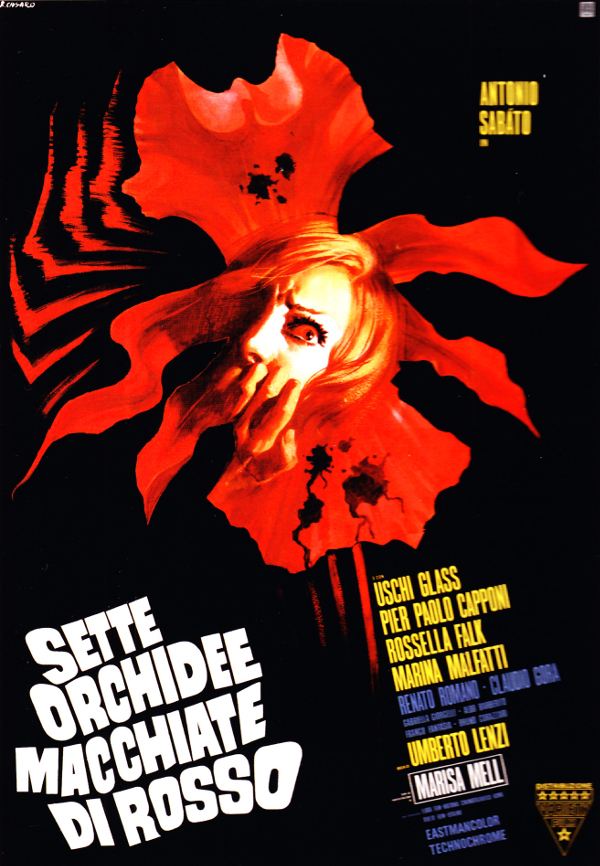With a title like Seven Blood-Stained Orchids, you’d probably expect a fascinating nature documentary divulging the secrets of a rare flower. . . but of course not, this is part of the continuing series of giallo films reviewed here on Filmizon.com.
Written and directed by Umberto Lenzi (and loosely based upon Cornell Woolrich’s novel “Rendezvous in Black”), the filmmaker immerses the viewer into a sordid tale of bloody revenge.
A murderer, dressed (and gloved) in black, is dispensing of women in and around the city of Rome. Seemingly with no connection – a prostitute (Gabriella Giorgelli), English artist (Marina Malfatti), mental patient (Rossella Falk – Black Belly of the Tarantula), teacher (Petra Schürmann), woman abroad (Marisa Mell), and a newly married lady, have clearly been naughty, as they have found their way onto the unseen assailant’s list (I will not divulge which of these women help the butcher come closer to completing his or her bucket list).
With many applicable monikers, the figure in black could also be called the telephone killer, as a call is always made to a woman just prior to contact, while another nickname that would fit is the half-moon maniac – as the attacker always leaves a silver half-moon trinket on the dead body he or she has left behind.
One woman lucky enough to escape the maniac is the newly married woman, Giulia (Uschi Glas), who was wounded on a train during her honeymoon. A case of being in the wrong place at the wrong time, her husband Mario (Antonio Sabato), finds himself a suspect, which forces the man to take on the role of private detective, looking into the mysterious string of attacks.
With only sporadic clues, he finds himself chasing a ghost of a man, American Frank Saunders, a one time diner at his wife’s family hotel (which she sold off after both meeting Mario as well as her mother’s death) who seems to have something to do with the macabre case. The name leads him to other patrons who were at the hotel the same day, numerous Protestant churches, a hippie sex/drug den, as well as several other places. And, each person that he visits gives him a look that is a tad unsettling – are any of these individuals trustworthy? Will the cops (who seem to lean towards incompetent in nearly every giallo) ever be able to stay one step ahead of the killer? Will the inexperienced Mario be able to solve the case, saving his wife from further harm in the process? Will any of the other endangered women find safety from this unknown attacker?
A film with visual panache, Umberto Lenzi furthers his tale of murder with a flawed purpose by adding a unique style. Fusing mystery and thrills with artistic images, it is like watching a darkly disturbing piece of art in motion. The director utilizes first person perspectives (where we only see the hand, flashlight, knife or shadow of the killer), jarring reactions from the women, long takes, fascinating settings (e.g. a woman’s stunning apartment, filled with striking pieces of art and three oft-mewing felines), dynamic cinematography by Angelo Lotti (finding striking shots of shadow and light – often at night), all done with an excellent handheld camera – it smooth enough to enjoy whilst also reminding us that we are watching the killer moving in those spectacular first person shots. All of this is paired with a suspense-driven score by Riz Ortolani – a unique jazz composition that adds something special to the Italian/German co-produced thriller.
Other, smaller performances also deserve a quick mention. . . the expressive face of Claudio Gora (an icon of the Italian film industry) pops up multiple times – a man with a photographic memory who doesn’t seem too sure of himself, while Pier Paolo Capponi plays the not wholly competent Inspector.
A slightly more restrained giallo, Seven Blood-Stained Orchids finds a delicate balance between plot, visual cadence, and suspenseful thriller, making for an entertaining feature that has aged very well (though like any film, it is not without its flaws). Shot with a nuanced eye in Rome, its Italian locales and high fashion looks only further its intrigue. Lastly, its influence on movie history can also be noticed, an influence on Brian De Palma and some of the giallo-like thrillers to come out in the United States into the late 1970s and 1980s. Though not an all-out classic, this one gets my blessing, a motion picture that submerges its audience in bloody terror from the very beginning until the splashy ending.
This film is in Italian with English subtitles


